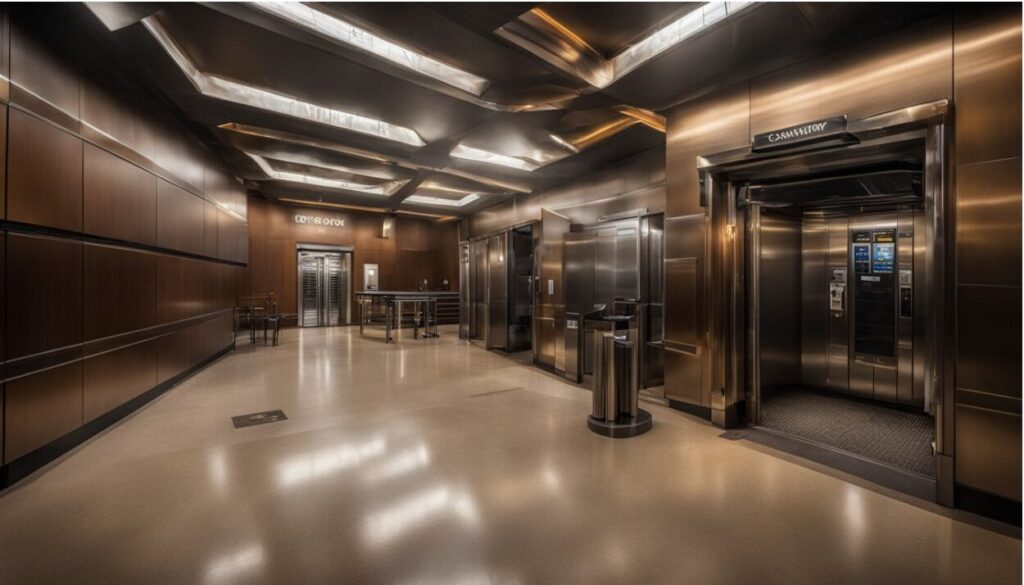Keeping elevators safe is a big deal for building owners and facility executives. You want to make sure everyone who rides an elevator in your building gets where they’re going without any problems.
Sometimes though, making sure everything stays up-to-date with safety inspections and new technology can be challenging.
Did you know? Elevators need to be checked regularly by experts outside your company to keep everyone safe. This blog post will show you how the future of keeping elevators safe is changing and why it’s good news for you.
We’ll talk about using new tech to share information quickly, testing how well emergency systems work, and planning ahead to fix things before they break down. Ready for safer elevators? Keep reading!
Future of Elevator Reporting and Compliance
The future of elevator reporting and compliance is all about using smart tech and clear rules. We’re heading towards a time where sharing data quickly and accurately will be normal in keeping elevators safe for everyone.
Sharing Information
Sharing information plays a crucial part in making elevators safer. Building owners, property managers, and maintenance personnel need to talk and share details often. Elevator maintenance companies ask for inspection reports from the EDTC with the building manager’s OK.
This helps everyone stay on top of elevator safety.
Connected elevators are smart because they can tell service teams quickly if something is wrong, leading to faster fixes. This means less waiting when an elevator needs repair. Sharing data like this makes sure elevators work well and safely.
Connected technology ensures quicker repairs and heightened safety in modern elevating systems.
Mandatory Testing for Emergency Communication
Moving from sharing information, we see how important communication is in emergencies, especially in elevators. Elevator emergency phones have a big job: they need to check if their alarm equipment is working well every three days.
This isn’t just a good idea; it’s a must-do for safety. Making sure these help phones meet code regulations helps everyone know what to do if there’s an elevator emergency.
Keeping up with mandatory compliance means building owners and facility executives can trust their elevator systems are safe and ready for any situation. It’s about more than just following rules; it’s ensuring quick, effective responses during emergencies through tested and reliable emergency communication systems.
Compliance isn’t only crucial—it could save lives by making sure that when someone needs help, the call goes through without a hitch.
Data-Driven Processes
After ensuring elevators can communicate in emergencies, the next step focuses on using data to keep these systems safe. Elevators are going smart, gathering tons of data every day.
This approach makes it easy for building owners and facility executives to see what’s happening with their lifts all in one place online.
Smart technology takes elevator maintenance into the future. It helps predict when a part might fail before it actually does—thanks to predictive maintenance powered by data analytics and IoT (Internet of Things).
This means less downtime for repairs and more safety for users. Plus, keeping up with compliance becomes simpler when you have all your information organized and accessible from anywhere, at any time.
Elevator Modernization for Improved Safety and Compliance

Updating elevators makes them safer and meets rules better. This leads to fewer accidents and happier people who use them.
Strategic Contract Management
Strategic contract management is key for building owners and facility executives. It helps them keep elevators safe while following the latest rules. Old, long-term maintenance contracts might not meet new safety standards anymore.
This means it’s time for a change. Building managers have to work smart with their contracts to make sure elevators are up-to-date and safe.
Good management looks at elevator maintenance as a partnership. This involves clear talks about what each side needs, regular check-ups, and updates on how things are going. The goal? To catch small problems before they turn big and costly.
With this approach, buildings stay safer and everyone knows what to expect from their elevators.
Predictive Maintenance
Predictive maintenance solutions are changing the game for elevators. They keep an eye on things before problems happen, making repairs faster and keeping everyone safe. This way, elevators work better, last longer, and stay safe.
It’s like having a health check-up for your elevator to catch issues early.
Sensors and data analysis play big roles in this new approach. Together, they spot tiny faults that humans might miss. This tech lets us fix things quicker and cut down on surprise breakdowns.
So, buildings run smoother, costs go down, and people feel safer using lifts. Elevator modernization isn’t just about looks; it’s about making everything work better behind the scenes.
Innovation in lift systems through predictive maintenance marks the start of smarter building management.
Biometric Access Control
Biometric access control is making buildings safer and more secure. It uses things like fingerprints, face scans, key cards, and PIN codes to let the right people in and keep others out.
This tech is great for spots that need extra safety because they hold important data or costly gear. More businesses now pick biometrics to make their workplaces safer. This means adding tools that can check fingerprints or even measure body heat before letting someone use the elevator.
This way of controlling who gets into an elevator cuts down on risks. It’s super helpful in buildings where security matters a lot. By switching to biometric authentication, business owners and facility managers can ensure only allowed persons use their elevators, adding an extra layer of protection against unauthorized access or threats.
Conclusion
The future of elevator safety compliance in contract management shines bright with innovations and stricter standards on the horizon. With AuditMate, navigating the advancing landscape becomes a seamless journey.
Their cutting-edge software ensures every elevator operates safely, meets all regulations, and adheres to maintenance contracts without a hitch. Elevator safety is not just about meeting current standards but also preparing for tomorrow’s challenges.
Let AuditMate guide you through this journey with their expertise in data-driven auditing and vendor management. Ready to elevate your elevator compliance? Reach out to AuditMate today!
FAQs
1. What’s new with elevator safety rules?
New rules are coming that focus more on regular checks and tech updates to keep everyone safe.
2. Will technology play a bigger role in elevator safety?
Yes, smart tech will help us catch problems before they get big, making elevators safer for everyone.
3. Do I need to know a lot about elevators to manage their contracts now?
Not really, but knowing the basics helps you make sure everything’s up to code and running smooth.
4. How often should we check our elevators for safety now?
More often than before — it’s all about catching issues early and keeping things in top shape.
5. Is it going to cost more to keep my elevators safe under these new rules?
It might at first, but think of it as saving money down the line by avoiding bigger problems.


